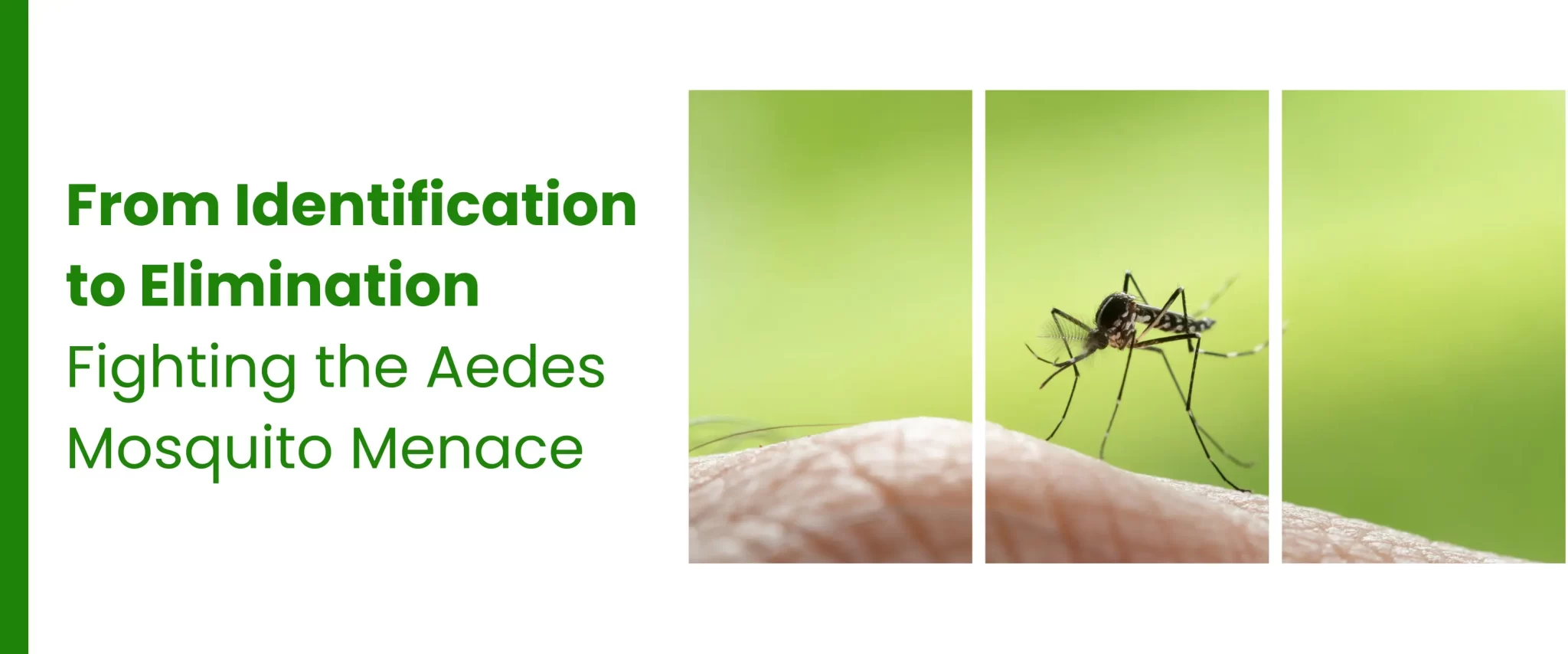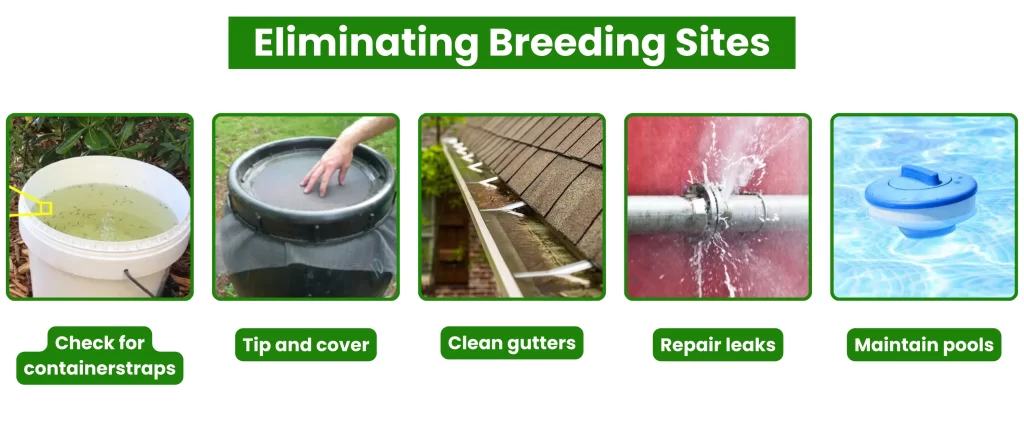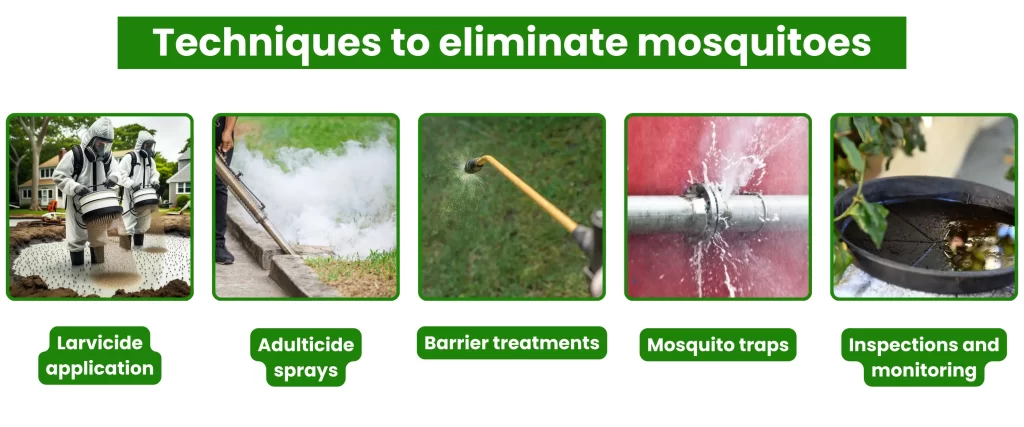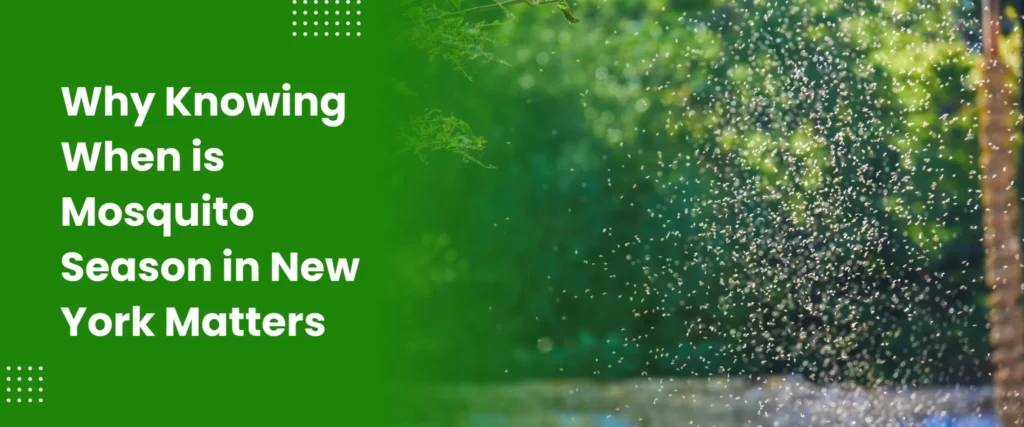
As the summer season brings warmer weather to New York City, it also heralds the arrival of mosquitoes. Among them, the Aedes mosquito stands out due to its ability to transmit serious diseases like dengue, Zika, and chikungunya. Identifying these mosquitoes season and understanding how to control mosquitoes population is crucial for public health and personal safety. In this blog, we will delve into the distinctive characteristics of Aedes mosquitoes, their life cycle, and effective strategies for preventing their breeding and bites.
Aedes Mosquitoes: A Vector for Dangerous Diseases

Aedes mosquitoes are notorious for transmitting a range of dangerous viruses, including:
- Dengue: A viral infection causing flu-like symptoms, severe joint pain, and potentially life-threatening complications.
- Zika: A virus primarily affecting pregnant women, as it can cause severe birth defects.
- Chikungunya: A viral disease characterized by fever, joint pain, and muscle pain.
The increasing prevalence of these diseases in various parts of the world, coupled with the potential for outbreaks in NYC, underscores the importance of recognizing and controlling Aedes mosquitoes.
How to Identify Aedes Mosquito?
Physical Characteristics
Aedes mosquitoes are relatively small, typically measuring around 4-7 millimeters in length. They are easily recognizable by their distinct black and white markings. One of the most prominent features is a lyre-shaped pattern on their thorax, resembling a musical instrument. Their legs also exhibit alternating bands of black and white.
It’s essential to differentiate Aedes mosquitoes from other common mosquito species found in NYC. For instance, Culex mosquitoes, which are more prevalent, have a more uniform brown coloration and lack the distinctive markings of Aedes.
Behavioral Traits
Unlike many other mosquitoes that are primarily nocturnal, Aedes mosquitoes are notorious for being daytime biters. This aggressive behavior increases the likelihood of human-mosquito contact and consequently, the risk of disease transmission.
Furthermore, Aedes mosquitoes have a strong preference for human blood. This specific attraction to humans makes them efficient vectors for diseases, as they are more likely to bite and infect people.
Life Cycle of Aedes Aegypti Mosquito

Egg Stage
Aedes aegypti mosquitoes lay their eggs in small containers that hold water, such as discarded tires, flowerpots, and bottle caps. The eggs are black and tiny, often laid just above the waterline or on dry surfaces that will eventually be flooded. Remarkably, Aedes aegypti eggs can survive long periods of desiccation, hatching when water becomes available, even months or years later. This adaptation contributes significantly to their ability to thrive in urban environments.
Larval Stage
The egg hatches into a larva, commonly known as a “wriggler.” These small, worm-like creatures live in the water and feed on organic matter. They have breathing tubes at the end of their bodies that they extend to the water’s surface for air. Aedes aegypti larvae prefer clean, stagnant water for their development.
Pupal Stage
After the larval stage, the mosquito transforms into a pupa, often called a “tumbler” due to its characteristic floating, tumbling motion. During this stage, the mosquito undergoes metamorphosis, developing adult features. The pupa does not feed and is relatively inactive.
Adult Stage
The adult mosquito emerges from the pupal casing. Females require a blood meal for egg production, while males feed on plant nectar. Aedes aegypti mosquitoes are notorious for their daytime biting habits and preference for human blood. The lifespan of an adult mosquito varies depending on environmental conditions, but it typically ranges from a few weeks to a month.
Aedes Mosquito Traps
Types of Traps
Several types of traps are available to capture Aedes mosquitoes:

- Oviposition traps: These traps mimic ideal egg-laying sites for female mosquitoes. They often contain water and attractants to lure females to deposit eggs.
- Sticky traps: These traps use a sticky adhesive to capture mosquitoes that come into contact with the trap. They are often baited with attractants to increase their effectiveness.
- Carbon dioxide (CO2) traps: These traps emit carbon dioxide, a substance that attracts mosquitoes. They are often used for monitoring mosquito populations but can also be used for control.
- Fan traps: These traps use a fan to draw mosquitoes into a collection chamber. They are often combined with attractants to increase their efficiency.
How Traps Work
Mosquito traps utilize various mechanisms to attract and capture mosquitoes:
- Attractants: Many traps employ attractants such as carbon dioxide, octenol (a human skin scent mimic), or heat to lure mosquitoes.
- Killing methods: Once mosquitoes are attracted to the trap, they can be captured using sticky adhesives, drowning in water, or being killed by an electric grid.
Effectiveness in NYC
The effectiveness of mosquito traps can vary depending on factors such as trap type, location, and target mosquito species. While traps can be helpful in reducing local mosquito populations, they are generally not sufficient for large-scale control. Combining traps with other control measures, such as larvicide applications and public awareness campaigns, is often more effective.
Recommendations for Best Traps Suited for Urban Environments
In urban environments, oviposition traps can be particularly useful for targeting Aedes aegypti, as they often breed in small containers. Sticky traps may also be effective for capturing adult mosquitoes, especially when placed near areas of high human activity. However, it’s essential to consider the specific conditions and target mosquito species when selecting a trap. Consulting with local pest control experts can provide valuable guidance on choosing the most appropriate trap for your needs.
How to Prevent Aedes Mosquito Breeding
Eliminating Breeding Sites
Aedes mosquitoes thrive in stagnant water. Eliminating these breeding grounds is crucial in preventing their population from exploding.

- Check for containers: Inspect your property for any containers that can hold water, such as old tires, buckets, flowerpots, and discarded items.
- Tip and cover: Tip over any containers that can hold water and cover those that cannot be removed.
- Clean gutters: Regularly clean gutters to prevent water accumulation.
- Repair leaks: Fix leaky faucets, pipes, and air conditioners promptly.
- Maintain pools: Ensure pools are properly chlorinated and covered when not in use.
Household Measures
Taking precautions within your home can significantly reduce the risk of Aedes mosquito bites:
- Install screens: Ensure all windows and doors have tight-fitting screens to prevent mosquitoes from entering.
- Repair leaks: Fix any leaks inside your home that could create standing water, such as dripping faucets or air conditioners.
- Empty water dishes: Regularly change water in pet dishes and bird baths.
- Check plants: Inspect plants for water-holding leaves or containers.
Outdoor Measures
Maintaining a mosquito-free outdoor environment is essential:
- Cover garbage cans: Keep garbage cans tightly covered to prevent rainwater accumulation.
- Maintain gardens: Regularly check gardens for containers, old pots, or stagnant water in saucers.
- Clean up debris: Remove any items that can hold water, such as old toys or discarded items.
- Use mosquito repellent: Apply insect repellent when spending time outdoors.
Aedes Aegypti Mosquito Prevention Tips
Personal Protection
Protecting yourself from Aedes mosquito bites is crucial in preventing the spread of diseases:
- Use repellent: Apply insect repellent containing DEET, picaridin, or other effective ingredients according to product instructions.
- Wear protective clothing: Cover exposed skin by wearing long-sleeved shirts, long pants, and socks.
- Avoid peak biting times: Reduce outdoor activities during dawn and dusk when mosquitoes are most active.
Community Efforts
Working together as a community can significantly impact Aedes mosquito populations:
- Participate in clean-up days: Join neighborhood clean-up initiatives to eliminate breeding sites.
- Report stagnant water: Inform local authorities about any stagnant water that cannot be addressed privately.
- Educate others: Spread awareness about Aedes mosquitoes and prevention measures within your community.
Importance of Professional Mosquito Control
While DIY methods can help reduce mosquito populations, professional pest control services offer several advantages:
- Expertise: Pest control professionals have in-depth knowledge of mosquito biology, behavior, and effective control methods
- Equipment and Products: They have access to specialized equipment and safe, industrial-strength pesticides that are not available to the public.
- Comprehensive Treatment: Professionals can identify and treat mosquito breeding sites both inside and outside your property.
- Long-term Solutions: They can develop a customized treatment plan to provide ongoing protection against mosquitoes.
- Time-saving: Hiring professionals saves you time and effort in managing mosquito control.
How Professionals Control Mosquitoes
Pest control companies employ various techniques to eliminate mosquitoes:

- Larvicide application: Targeting mosquito larvae in their breeding sites.
- Adulticide sprays: Applying insecticides to kill adult mosquitoes.
- Barrier treatments: Creating a protective barrier around your property to repel mosquitoes.
- Mosquito traps: Using specialized traps to capture and kill adult mosquitoes.
- Inspections and monitoring: Regular inspections to identify potential breeding sites and track mosquito populations.
When to Call a Professional
Consider contacting a professional pest control service if:
- You have a persistent mosquito problem despite your best efforts.
- You suspect you have a mosquito-borne illness.
- You are planning a large outdoor event.
- You live in an area with a high risk of mosquito-borne diseases.
By utilizing the expertise of professional pest control, you can significantly reduce the mosquito population on your property and protect yourself and your family from the health risks associated with these pests.
Conclusion
Understanding the Aedes mosquito, its life cycle, and the diseases it carries is crucial to protecting yourself and your community. By learning to identify these pests, eliminating their breeding grounds, and taking personal precautions, you can significantly reduce the risk of mosquito-borne illnesses.
Remember, prevention is key. Everyone has a role to play in controlling the Aedes mosquito population. By working together as a community, we can create a safer environment for everyone.


